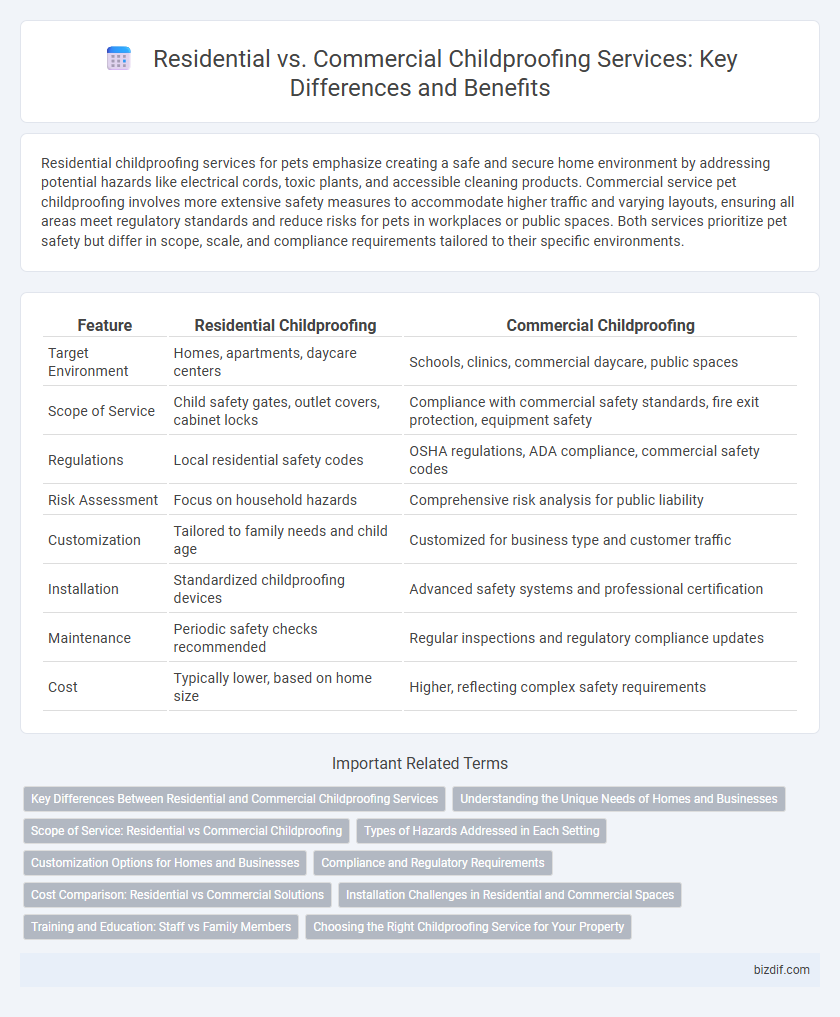Residential childproofing services for pets emphasize creating a safe and secure home environment by addressing potential hazards like electrical cords, toxic plants, and accessible cleaning products. Commercial service pet childproofing involves more extensive safety measures to accommodate higher traffic and varying layouts, ensuring all areas meet regulatory standards and reduce risks for pets in workplaces or public spaces. Both services prioritize pet safety but differ in scope, scale, and compliance requirements tailored to their specific environments.
Table of Comparison
| Feature | Residential Childproofing | Commercial Childproofing |
|---|---|---|
| Target Environment | Homes, apartments, daycare centers | Schools, clinics, commercial daycare, public spaces |
| Scope of Service | Child safety gates, outlet covers, cabinet locks | Compliance with commercial safety standards, fire exit protection, equipment safety |
| Regulations | Local residential safety codes | OSHA regulations, ADA compliance, commercial safety codes |
| Risk Assessment | Focus on household hazards | Comprehensive risk analysis for public liability |
| Customization | Tailored to family needs and child age | Customized for business type and customer traffic |
| Installation | Standardized childproofing devices | Advanced safety systems and professional certification |
| Maintenance | Periodic safety checks recommended | Regular inspections and regulatory compliance updates |
| Cost | Typically lower, based on home size | Higher, reflecting complex safety requirements |
Key Differences Between Residential and Commercial Childproofing Services
Residential childproofing services prioritize home safety tailored to children's daily living spaces, focusing on hazards like sharp furniture edges, electrical outlets, and staircases. Commercial childproofing involves larger-scale safety measures designed for public or business environments, addressing higher traffic areas, regulatory compliance, and diverse age groups. Key differences include the scope of protection, regulatory standards, and customization based on residential comfort versus commercial operational needs.
Understanding the Unique Needs of Homes and Businesses
Residential childproofing services prioritize the safety of infants and young children by securing furniture, installing safety gates, and covering electrical outlets tailored to typical home environments. Commercial childproofing focuses on compliance with safety regulations and accommodating higher foot traffic, ensuring public spaces, daycare centers, and businesses minimize hazards effectively. Understanding these distinct needs allows professionals to customize solutions that address the specific risks in homes versus commercial establishments.
Scope of Service: Residential vs Commercial Childproofing
Residential childproofing primarily targets common household hazards such as sharp corners, electrical outlets, stairs, and cabinets to create a safe environment tailored for infants and toddlers. Commercial childproofing entails a broader scope involving compliance with stringent safety regulations, encompassing playground safety, emergency exits, and durable protective installations suitable for higher foot traffic and varied child age groups. Both services emphasize hazard identification but vary significantly in scale and regulatory requirements.
Types of Hazards Addressed in Each Setting
Residential childproofing services primarily focus on hazards such as sharp furniture edges, electrical outlets, staircases, and toxic household chemicals to protect children in home environments. Commercial childproofing addresses unique dangers including heavy machinery, industrial equipment, high-traffic areas, and secure access points suited to public or workplace safety regulations. Tailored strategies ensure effective mitigation of environment-specific risks, enhancing child safety across residential and commercial settings.
Customization Options for Homes and Businesses
Residential childproofing services offer tailored solutions addressing specific household risks such as securing cabinets, covering electrical outlets, and installing safety gates designed for varied home layouts. Commercial childproofing services focus on regulatory compliance and high-traffic safety, customizing barriers, signage, and secure zones to protect children in daycares, medical offices, and retail environments. Customization options for homes prioritize family lifestyle and child age, while commercial options emphasize durability, ease of maintenance, and legal safety standards.
Compliance and Regulatory Requirements
Residential childproofing services prioritize safety standards specific to home environments, such as securing furniture and covering electrical outlets to meet local building codes. Commercial childproofing services must adhere to stricter regulatory requirements, including OSHA guidelines and ADA compliance, ensuring public spaces are safe for children while accommodating accessibility. Both services require thorough inspections and use certified products to meet federal, state, and municipal safety regulations.
Cost Comparison: Residential vs Commercial Solutions
Residential childproofing services typically cost less due to smaller spaces and fewer hazards, with average expenses ranging from $150 to $500 per project. Commercial childproofing involves higher costs, often exceeding $1,000, reflecting larger areas, stricter safety regulations, and specialized materials designed for frequent public use. Budget planning should account for these differences, emphasizing customized solutions for residential settings and comprehensive compliance for commercial environments.
Installation Challenges in Residential and Commercial Spaces
Residential childproofing installations often face challenges such as varied furniture layouts, uneven walls, and the need to preserve aesthetic appeal while ensuring safety. In commercial spaces, installation must accommodate higher foot traffic, larger open areas, and stricter compliance with industry safety standards and building codes. Both environments require tailored solutions to effectively mitigate hazards while maintaining functionality and accessibility.
Training and Education: Staff vs Family Members
Residential childproofing services emphasize training and education for family members to ensure safe practices within the home, focusing on identifying common household hazards and proper use of safety devices. Commercial childproofing services prioritize comprehensive staff training programs tailored to regulatory compliance and emergency preparedness, equipping employees with the skills to maintain child safety in public or daycare environments. Both services utilize specialized educational materials, but commercial settings require ongoing certification and periodic retraining to adhere to safety standards.
Choosing the Right Childproofing Service for Your Property
Residential childproofing services prioritize creating a safe environment tailored to the unique layout and hazards of family homes, focusing on securing furniture, outlets, and sharp edges. Commercial childproofing services address larger-scale safety concerns in daycare centers, schools, and offices, emphasizing compliance with strict regulations and accommodating high-traffic areas. Selecting the right childproofing service depends on property type, specific safety needs, and adherence to local safety standards to ensure comprehensive protection.
Residential Service vs Commercial Service Infographic

 bizdif.com
bizdif.com